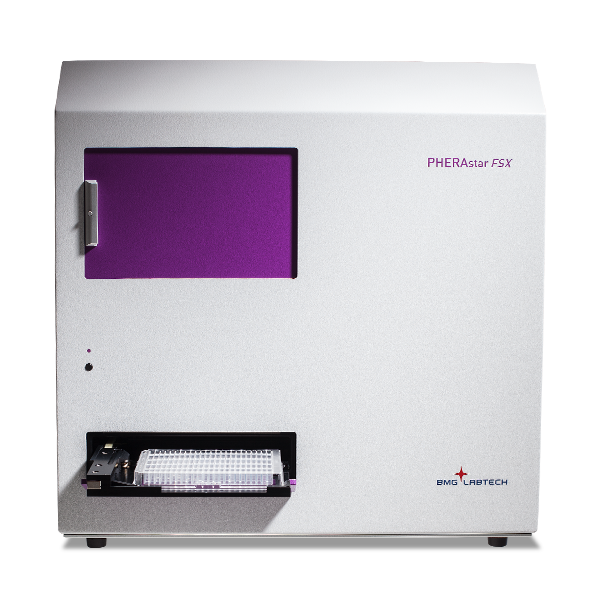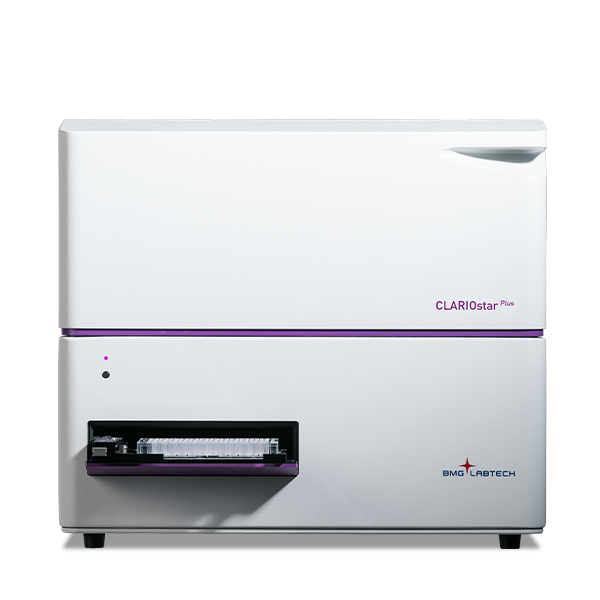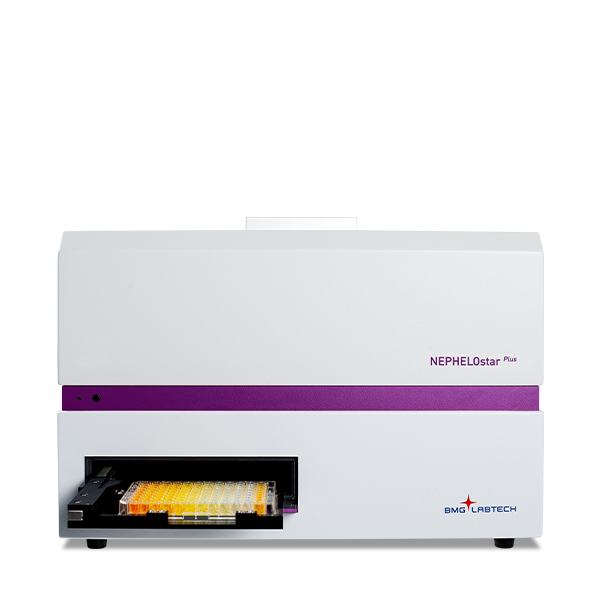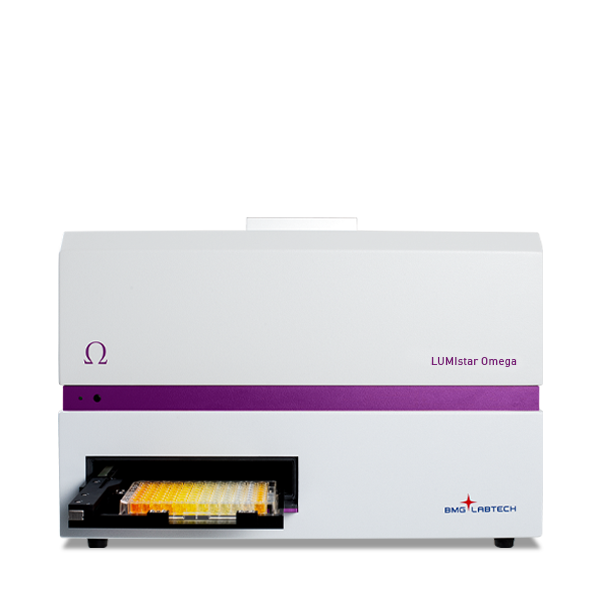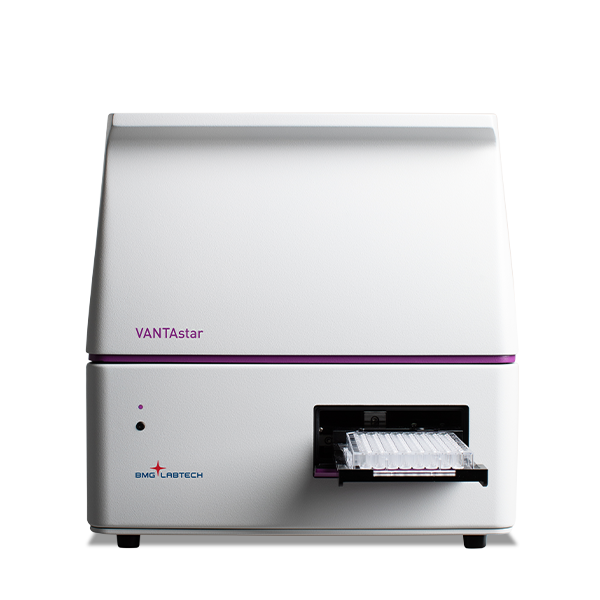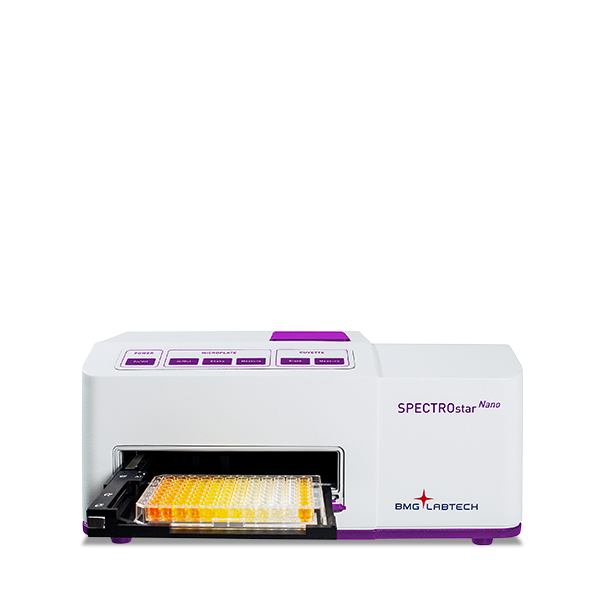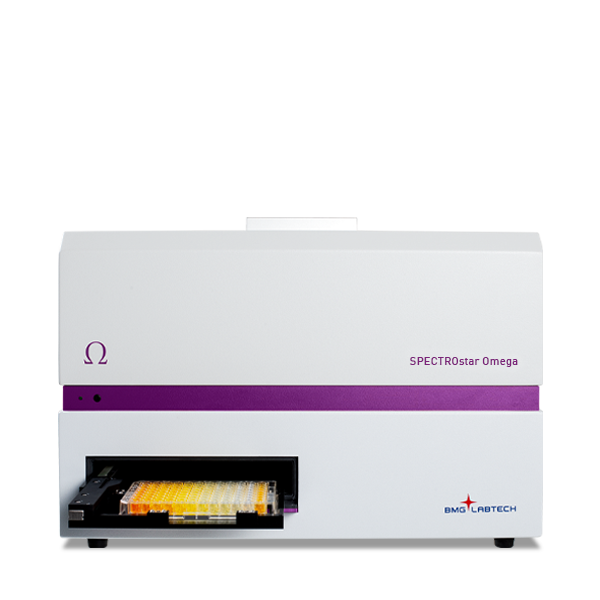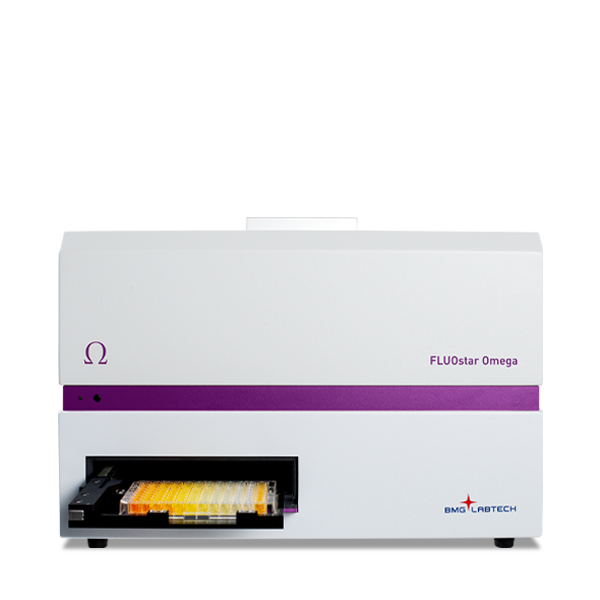
Basic information about fluorescence plate readers
What is a fluorescence plate reader?
A fluorescence plate reader, (longform: fluorescence microplate reader; shortform: fluorescence reader) also called spectrofluorometer or fluorometer, is a piece of equipment capable of detecting and quantifying the light photons emitted by a fluorescent sample present in a microplate upon excitation with light at a specific wavelength.
Fluorescence plate readers are usually intended for fluorescence intensity and FRET detection. Other detection modes such as fluorescence polarization or time-resolved fluorescence and TR-FRET can only be detected by multi-mode microplate readers and not at all by single-mode fluorescence microplate readers. To additionally cover also these detection modes, as well as absorbance and luminescence measurement, multi-mode microplate readers are usually required.
Fluorescence microplate readers usually contain a light source, an optical system for the selection of the incoming light (i.e., filters and/or monochromators), a second optical system for the selection of emission light, and a detector, usually a photomultiplier tube (PMT). These convert photons generated by fluorescencent or luminescent dyes into electricity that is then quantified by the microplate reader. The output of this process is numbers by which a sample is quantified.
As opposed to absorbance measurements, fluorescence detection is not an absolute measurement. The intensity of the fluorescent signal is usually relative to other measurements or to a refence measurement taken by an instrument. Consequently, fluorescence plate readers measure the light signal emitted by a sample in Relative Fluorescent Units (RFU).
Fluorescence plate readers are available as stand alone, dedicated readers (fluorometers) or, as part of multi-mode microplate readers, when combined to absorbance and/or luminescence detection.
Fluorescence plate readers are used for different applications in various fields, such as academic life science research, drug discovery and screening, clinical laboratories, synthetic biology and food or water quality monitoring.
Do you want to use a fluorescence plate reader in your lab?
Request a quote or more information here:
- Initial recommendation
- Detailed Recommendation

Get help selecting the right microplate reader
Configure your microplate reader and get an initial recommendation!

If you are on the market for a new fluorescence microplate reader (single or multi-mode), there are a few factors to take into account, as the performance of the instrument can significantly affect the quality of your research results.
Sensitivity
For quantification purposes, fluorescence plate readers generally offer superior sensitivity than absorbance readers. Nevertheless, a fluorescence microplate reader with high sensitivity will deliver data with a better statistic, less variability among replicates, and a larger delta (distance) between responding and not-responding samples. In addition, a greater sensitivity will allow you to reduce the amount of reagents and/or samples used to achieve good quality results and consequently reduce your costs.
Dynamic range
In fluorescence detection, samples often cover a vast range of concentrations. Signals that have to be measured on a fluorescence microplate reader may span over a wide range of intensities – from dim to very bright. Moreover, enzymatic or cell based kinetic assays are often hard to predict in their signal intensity, as their maximum signal builds up over a lapse of time during the course of the kinetic analysis.
In these cases, it may be difficult to acquire all samples in one measurement with one setting. Very bright samples may saturate the detector of the microplate reader. Very dim samples may be undiscernible from the blanks.
Having a large dynamic range allows your fluorescence plate reader to acquire highly divergent intensities in one run, avoiding waste of reagents and time caused by multiple trial-and-error measurements to find the correct dilution to fluorescence gain ratio. The Enhanced Dynamic Range feature on the PHERAstar FSX, CLARIOstar Plus and VANTAstar offers the largest possible dynamic range on the market (8 concentration decades), and makes it possible to automatically measure assays with very strong signals and dim signals in the same measurement – no adjustment required.
Wavelength selection
The capability to select wavelengths in fluorescence microplate readers is mandatory both for excitation and emission. This helps to reduce unspecific background or noise that is usually caused by light scatter or autofluorescence from both the sample and the microplate.
Filters or monochromators can be employed for this purpose. Filters are usually more sensitive, whereas monochromators offer more flexibility. An exception to this paradigm is Linear Variable Filter (LVF) Monochromator system available on the CLARIOstar Plus and VANTAstar. LVF Monochromators have filter-like performance and make the CLARIOstar Plus the most sensitive monochromator-based microplate reader on the market. LVF Monochromators can be used in fluorescence intensity and luminescence. In addition, monochromators have the capability to acquire excitation or emission scans.
Additionally, the capability of detecting two emission channels simultaneously is quite beneficial for FRET assays. This option halves measurement time and reduces data variability. Simultaneous Dual Emission (SDE) detection is available on the PHERAstar FSX and is an option on the LUMIstar Omega and FLUOstar Omega.
Compatible plate formats
Commonly in life science research, basic fluorescencent assays are measured in 96 well microplates. However, if you have multiple samples, have high-throughput needs and/or wish to work with micro-volumes to save precious reagents or time, 384 well and 1536 well plate formats can also be used. Just make sure that your fluorescence microplate reader of choice is also capable of reading the plate formats you plan on using. Moreover, absorbance, fluorescence, and luminescence detection require different plate types.
Reagent injectors
When looking for a fluorescence plate reader, you should consider the nature of the assay you want to run. For enzymatic kinetic analyses or real-time cell-based responses, the use of reagent injectors can be beneficial. By manually pipetting reagents into the wells you can run the risk of losing important data of your reaction. Especially for fast responses, the event you are looking for may already be gone before you detect it. Our fluorescence plate readers equipped with reagent injectors can simultaneously inject and detect the signal of a well, and then move to the next one.
Environmental control
If your research requires long-time live cell based assays (e.g., for cell viability studies) and you do not want to shuffle your microplate back and forth between fluorescence microplate reader and incubator, make sure that your reader of choice has the capability to control its internal gas environment.
The Omega series, the VANTAstar and the CLARIOstar Plus can be equipped with our Atmospheric Control Unit (ACU). The ACU provides the ideal environment for any application with living cells. The ACU independently regulates both O2 and CO2 gas levels within the microplate reader chamber. Combined with shaking and temperature incubation, the ACU provides a real “walk-away” solution for any cell-based assay from standard cell growth to hypoxia.
Software for data reduction
Generally, the software that runs the microplate reader is a very underestimated part of the package. For some readers, the software only controls the measurement process and provides a raw assay data output. In other cases, it can perform complex analyses.
A comprehensive, easy-to-use and flexible software can make life easier, simplify detection and data analysis so that you can get the most out of your instrument.
The most useful calculation features for fluorescencent assays include automatic blank subtraction, automatic calculation of concentrations based on standard curves, and enzymatic constants such as Km and Vmax.
On the BMG LABTECH software package, the most common assays have predefined quick-run assay-specific protocols and dedicated analysis templates. Through these dedicated solutions, acquisition and analysis of your results are performed with a single mouse click, enabling researchers to carry out experiments quickly and easily.
![]()
Our fluorescence intensity plate readers
Fluorescence detection can be performed on the PHERAstar® FSX, CLARIOstar® Plus, VANTAstar and FLUOstar® Omega microplate reader.
All our fluorescence microplate readers are equipped with a high-intensity xenon flashlamp, assay-specific filters, optic modules, or LVF monochromators™ (reader-dependent), and low-noise or extended red-shifted PMTs.

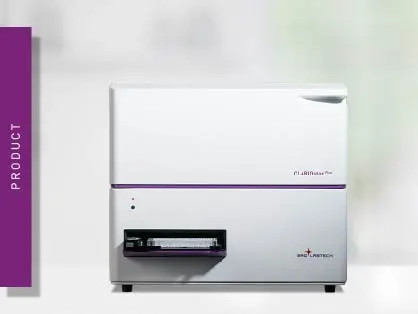
CLARIOstar Plus
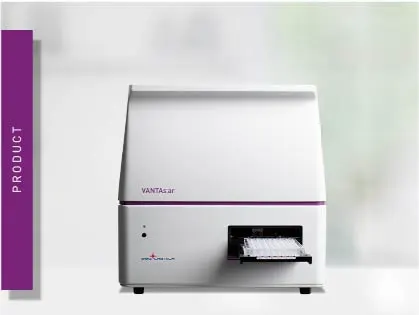
VANTAstar
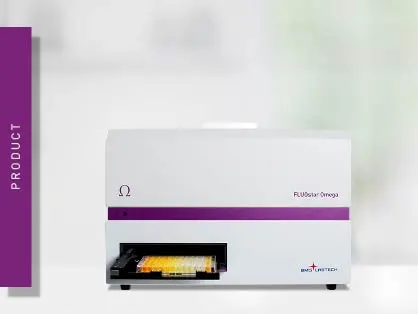
Omega Series
Which assays can be measured by a fluorescence plate reader?
Fluorescence intensity is one of the most popular detection modes in life science. Accordingly, there is a multitude of kits available on the market for the most different assay types that fluorescence microplate readers both as single- or multi-mode instruments can cover.
Common applications are DNA/RNA quantification, calcium assays (flux and signalling), enzymatic activities, gene expression, second messenger signalling for GPCRs, reporter assays, protein-nucleic acid interaction, tryptophan quantification, molecular beacon, biosensors for wastewater analysis and more.
Cell based applications include apoptosis assays, cell viability, cell proliferation, transfection efficiency and cytotoxicity.
Protein interaction can be detected via Förster Resonance Energy Transfer (FRET). FRET is a dual dye fluorescencent detection assay based on energy transfer between a donor and an acceptor. If donor and acceptor are in close proximity (10-100 Å), excitation of the donor fluorophore transfers energy to the acceptor fluorophore that will emit light without being directly excited.
Examples of Fluorescence intensity/FRET measurements:
The following assays are examples of fluorescence intensity and FRET measurements taken on BMG LABTECH fluorescence plate readers:
- AN368: Pyruvate kinase inhibitor measurements and effortless data analysis using the MARS data analysis software
- AN364: Antioxidant capacity determination in plant samples and food products with the microplate reader CLARIOstar Plus
- AN353: Studying the molecular mechanism of viral replication in real time using the CLARIOstar Plus with ACU
See a complete list of fluorescence intensity application notes.
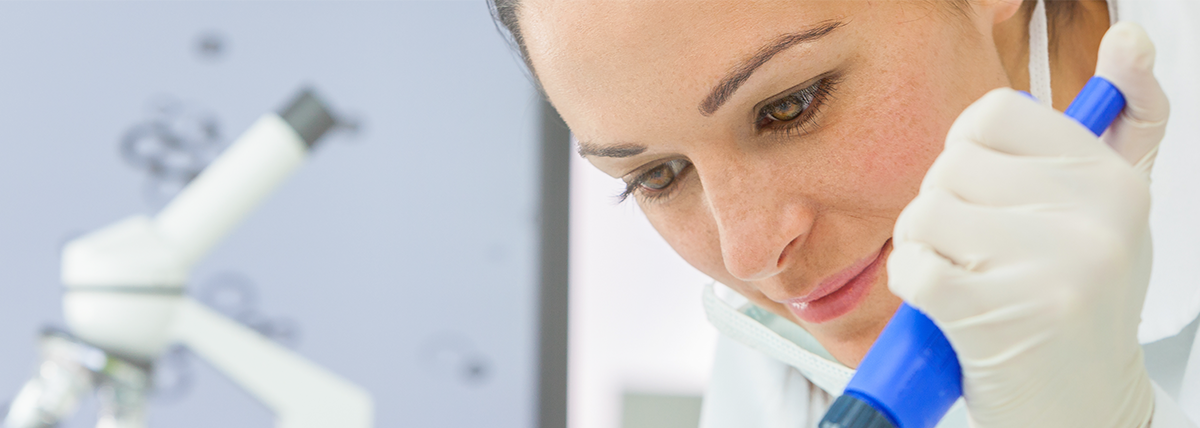
Why to choose a BMG LABTECH fluorescence plate reader?
BMG LABTECH is specialised in producing microplate readers only and brings more than 30 years of full expertise in microplate reading technology. This knowledge gets visible in the results that our instruments deliver - the only factor that counts in your lab! BMG LABTECH users can trust to obtain best results in sensitivity, speed and flexibility. Moreover, our multi-mode microplate readers are developed to provide high performance for years. Our instruments are developed, produced and tested in Germany and are built to be extremely robust and reliable.
Buy only what you need
Due to their modularity, all our fluorescence plate readers can be equipped with different detection modes and cover a multitude of applications. Additional features can be upgraded at any time. This gives you the chance to keep your options open even if you don’t use the full scope of your microplate reader right at the bat.
All-round service and support
We strive to provide you with the very best customer service. All sales area representatives are highly trained technical specialists able to support both the hardware, software and most application questions. For the most complex applications solutions a team of dedicated application specialists are also available.
Multi-user software package
All our instruments come with a multi-user integrated software package that can be installed on as many computers as users requires, without the need to purchase licenses. Software updates for our microplate readers are of no charge within the first 12 month after purchase.




